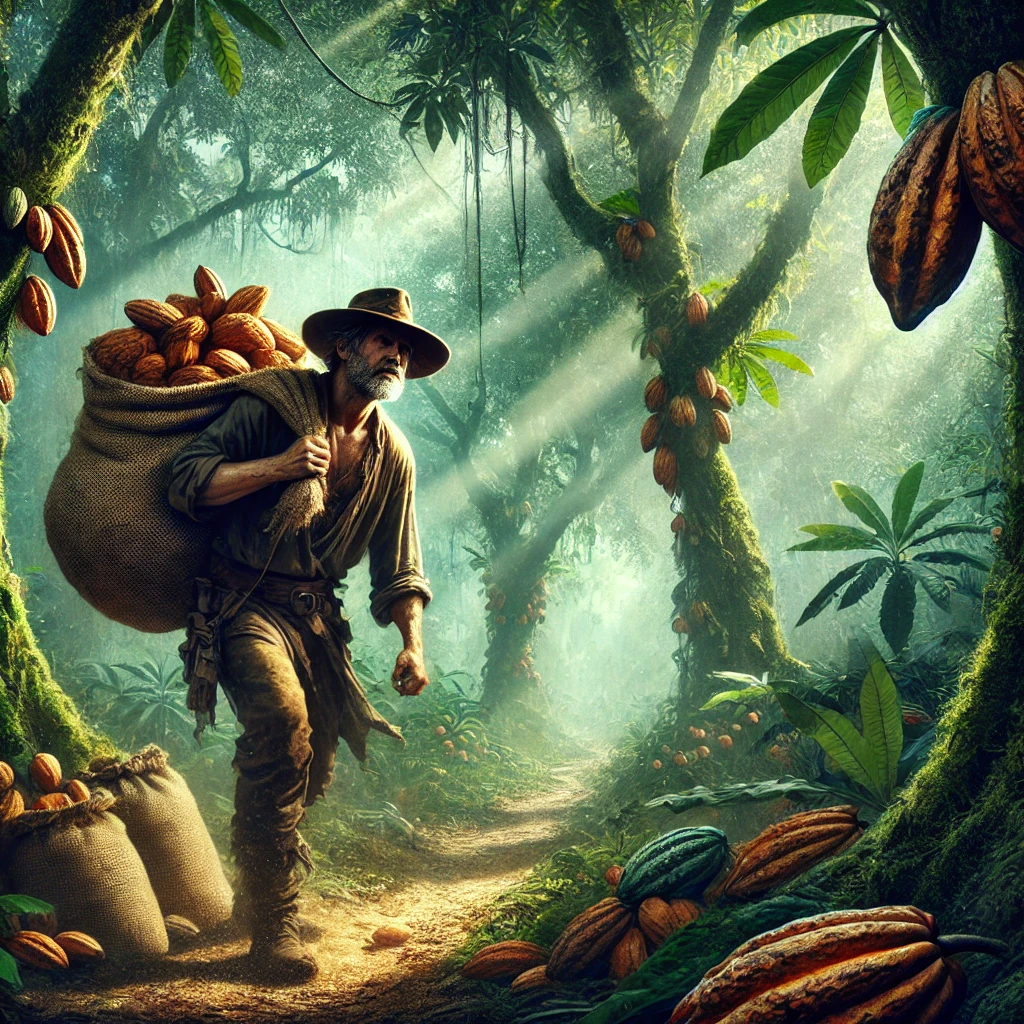 Chocolate, often seen as a symbol of indulgence and luxury, hides a world of intrigue beneath its glossy surface. While most people savour its smooth textures and complex flavours, few are aware of the covert operations, industrial espionage, and even scandals that have shaped the chocolate industry. Like any high-stakes global business, chocolate has its share of secrets—and those willing to go to great lengths to uncover them.
Chocolate, often seen as a symbol of indulgence and luxury, hides a world of intrigue beneath its glossy surface. While most people savour its smooth textures and complex flavours, few are aware of the covert operations, industrial espionage, and even scandals that have shaped the chocolate industry. Like any high-stakes global business, chocolate has its share of secrets—and those willing to go to great lengths to uncover them.
The Secrets Behind the Bean
Cocoa is a billion-dollar industry, and with so much at stake, it’s no wonder that companies guard their recipes, supply chains, and sourcing strategies like state secrets.
The art of blending cocoa beans, the development of new flavours, and the quest for the smoothest melt can lead to intense rivalries.
The intrigue surrounding cocoa isn’t a modern phenomenon. In fact, the history of cocoa is steeped in deception. The Mayans and Aztecs once valued cacao beans so highly that they used them as currency.
This practice inevitably led to one of the earliest known examples of food-related fraud—the creation of counterfeit cocoa beans. Archaeological evidence and historical records suggest that hollowed-out or painted fake beans were used to trick merchants and accumulate wealth. This ancient form of currency manipulation highlights how cocoa has long been at the centre of both value and deception.

One of the most notorious cases of modern chocolate espionage occurred in 2015 when Barry Callebaut, one of the world’s largest chocolate manufacturers, faced allegations of trade secrets being stolen.
An ex-employee was accused of passing sensitive information to a competitor, potentially costing the company millions. Though resolved quietly, the incident highlighted how valuable proprietary techniques and recipes are in the competitive confectionery world.
The Sabotage at Hotel Chocolat
In one of the more bizarre episodes of chocolate sabotage, renowned chocolatier Barry Colenso, who was once the head of patisserie at the Savoy Hotel and later worked with Thorntons, found himself at the centre of a scandal. In 2007, Colenso was caught damaging Hotel Chocolat stock at one of their Nottingham stores. Witnesses observed him handling truffles "in a suspicious manner," and it was soon discovered that several chocolates had been deliberately squashed and spoiled, causing damage worth £63.50.
Though the financial impact was minor, the reputational fallout was significant. Colenso admitted to "inappropriate handling" of the stock and resigned from his position at Thorntons shortly afterward. The incident sparked discussions about the intense rivalries within the high-end chocolate world, where competition sometimes spills over into personal actions.
Despite this controversy, Colenso continued his career and went on to work on high-profile projects, including contributing to the creation of the chocolate wedding cake for Prince William and Catherine Middleton’s royal wedding in 2011.

Not all chocolate espionage happens in the labs and boardrooms—some of it plays out in the jungles where cocoa is grown. In countries like Ivory Coast and Ghana, which supply over 60% of the world’s cocoa, smuggling networks have flourished. Farmers often sneak beans across borders to avoid taxes or to sell at higher prices in neighbouring countries. These covert operations destabilise markets and fuel illegal trade, leading to millions in lost revenue for governments and cocoa cooperatives.
The Ghana Cocoa Board reported significant losses due to beans being smuggled into Ivory Coast, where prices were temporarily higher. In response, both governments introduced stricter border controls and surveillance, turning the cocoa trade into a cat-and-mouse game.
Child Labour in Cocoa Production: Whistleblowers in the Shadows
Beneath the glossy surface of chocolate bars lies a much darker story—one that required espionage of a different kind to be exposed. The use of child labour in cocoa farming has been one of the industry’s most persistent scandals. Despite pledges from major chocolate manufacturers to eradicate this practice, children, some as young as five, continue to work under hazardous conditions in cocoa fields across Ivory Coast and Ghana.
Bringing these abuses to light wasn't easy. It required the courage of whistleblowers and human rights advocates who, in some cases, had to act like corporate spies to gather evidence. Investigators went undercover in cocoa farms, documenting the use of child labour, while insiders within chocolate corporations leaked documents and internal communications that revealed how deeply entrenched the problem was.
One of the most significant figures in this fight is Terry Collingsworth, a human rights attorney who led several legal cases against major chocolate companies, including Nestlé, Cargill, Mars, Mondelēz, Hershey, Barry Callebaut, and Olam. His investigations uncovered that, despite public pledges, these companies had profited from cocoa harvested using forced child labour.
Through a combination of field investigations and insider whistleblowing, Collingsworth was able to build legal cases under the Alien Tort Claims Act, holding these corporations accountable for their role in perpetuating exploitative labour practices. The evidence collected often revealed that companies had knowledge of these abuses but failed to implement effective solutions, choosing instead to maintain profitable supply chains.
These revelations were only possible thanks to whistleblowers—both on the ground in West Africa and within corporate offices—who risked their careers and safety to expose the truth.
The Mast Brothers Controversy: Unwrapping the Truth
In the late 2000s, Rick and Michael Mast, known as the Mast Brothers, emerged as pioneers in the American craft chocolate movement. Their brand was celebrated for its "bean-to-bar" philosophy, emphasizing transparency and artisanal methods.
However, in 2015, allegations surfaced challenging the authenticity of their claims.
Investigations revealed that, during their early operations, the Mast Brothers may have used commercially produced chocolate, specifically from the French supplier Valrhona, which they melted down, repackaged, and sold as their own. This practice contradicted their marketed image of producing chocolate directly from cocoa beans.
The brothers later admitted to using couverture chocolate in their initial experiments but maintained that they transitioned to a true bean-to-bar process as their production evolved. Nevertheless, the scandal exposed how the craft food industry can sometimes prioritise image over integrity.
The Hunt for the Perfect Bean
Beyond financial espionage, there’s a quieter, more subtle form of intelligence gathering: tracking down rare and valuable cocoa varieties. Some of the most prized beans, like Criollo or the elusive Nacional from Ecuador, are worth their weight in gold to artisan chocolatiers. In 2009, a team of researchers made headlines when they rediscovered a pure strain of Nacional, thought extinct, in a remote Ecuadorian valley. The location was kept secret for years, as the demand for this ancient variety soared.
Chocolatiers have been known to go to great lengths to secure exclusive rights to specific cocoa plantations or even “poach” rare clones. It’s a world where genetics matter, and a single discovery can change a brand’s fortunes overnight.
When Recipes Become Classified
Luxury chocolate brands often operate with the same level of secrecy as fine perfume houses. Recipes for signature blends and pralines are sometimes treated as classified documents. In 2011, Belgian chocolatier Pierre Marcolini filed a lawsuit after a former employee was accused of leaking recipes to a rival. The case, though quietly settled, underscored the value placed on intellectual property in the industry.
Even on the mass-market side, companies like Cadbury have fought legal battles over proprietary techniques. In the UK, 
The Sweet Risks of Innovation
As the industry evolves, new forms of espionage emerge. With the rise of bean-to-bar movements and the push for transparency, small producers sometimes find themselves in the crosshairs. There have been incidents where start-ups have accused larger corporations of stealing their direct-trade models or mimicking unique flavour profiles after visiting their workshops under the guise of “collaborations.”
Meanwhile, the race for sustainable cocoa and climate-resilient crops has added another layer of intrigue. Genetic research labs working on drought-resistant cocoa strains have faced cyber-attacks, raising questions about who might benefit from sabotaging such efforts.
In the world of chocolate, it seems, nothing is as sweet as it seems.
While we unwrap our favourite bars, it’s worth remembering that behind every silky ganache and crisp praline lies a world of fierce competition, guarded secrets, and—sometimes—a dash of espion
